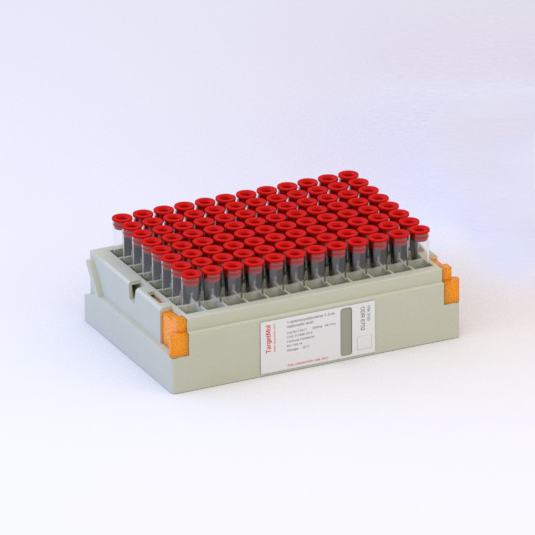L-glutamine is a non-essential amino acid that is often simply called glutamine. It is produced by the body. Glutamine is synthesized from NH4+ and glutamate. The conversion of glutamate to glutamine is regulated by glutamine synthetase (GS) and is a key step in nitrogen metabolism. Although normally synthesized in adequate amounts, endogenous glutamine production may be inadequate during periods of metabolic stress or under the condition of disease.
Glutamine is crucial for many metabolic functions, including protein and glutathione synthesis, energy production, maintenance of optimal antioxidant status, and immune function. Glutamine is the main metabolic substrate of macrophages and important for the function of macrophages; Glutamine is an important biosynthetic precursor for amino acid, protein and nucleic acid synthesis; Glutamine serves as a source of fuel for the cells lining the intestines, and without it, these cells may waste away; Glutamine is significantly involved in the synthesis of glutathione, a very important intracellular antioxidant and detoxication factor.
Cancer cells undergo a reprogramming of metabolism in order to maintain bioenergetics, redox status, cell signaling and biosynthesis, in what is often a poorly vascularized, nutrient-deprived microenvironment. A metabolic characteristic of many cancer cells is a dependence on an exogenous supply of glutamine, exhibiting “glutamine addiction”. Glutamine enters the cell through the amino acid transporter, ASCT2/SLC1A5, and is converted to glutamate in the mitochondria through a deamination reaction catalyzed by glutaminase (GLS). Glutamate is converted to the TCA cycle intermediate α-ketoglutarate (α-KG) by either glutamate dehydrogenase (GDH) or by the alanine or aspartate transaminases (TAs), which produce their corresponding amino acid in addition to α-KG, a process termed glutaminolysis. Humans express 4 isoforms of glutaminase which is the restriction and initiation enzyme in the glutaminolytic pathway. GLS encodes 2 types of kidney-type glutaminase with a high activity and low Km. GLS2 encodes 2 forms of liver-type glutaminase with a low activity and allosteric regulation.
Glutamine coordinates intracellular signaling to promote cancer growth in addition to acting as an important substrate for carbon and nitrogen production. For example, MYC transcriptionally represses miR-23a/b, leading to higher expression of mitochondrial glutaminase. Glutamine stimulates mTORC1 activity and in turn, impairs autophagy initiation through the negative regulation of ULK1 by several mechanisms. Thus, intervention in glutamine metabolic processes could provide novel approaches to improve cancer treatment.
TargetMol owns a unique collection of 580 compounds targeting the mainly proteins and enzymes involved in glutamine metabolism pathway. Glutamine Metabolism compound library is a useful tool for research in glutamine metabolic processes and drug discovery.

| パッケージサイズ |
|---|
| 1 mg |
| 30 μL * 10 mM (in DMSO) |
| 50 μL * 10 mM (in DMSO) |
| 100 μL * 10 mM (in DMSO) |
| 250 μL * 10 mM (in DMSO) |
| Empty | 1000025-07-9 | 1000413-72-8 | 229005-80-5 | 1000787-75-6 | 946387-07-1 | 1000998-59-3 | 1175526-27-8 | 1001288-58-9 | 1001350-96-4 | 1001404-83-6 | Empty |
| Vadadustat | TAK875 | TAK-779 | Tegobuvir | RN-1734 | BMS-687453 | AM211 | FT011 | BMS754807 | AAI101 | ||
| Empty | 1001625-82-6 | 1001645-58-4 | 1001753-24-7 | 1001908-89-9 | 1002304-34-8 | 1002-84-2 | 100291-86-9 | 100299-08-9 | 10030-52-1 | 10040-45-6 | Empty |
| RPW-24 | SRT1720 hydrochloride | INH6 | SRT 2183 | AMG208 | Pentadecanoic acid | Apiopaeonoside | Pemirolast potassium | L-Anserine nitrate salt | Sodium Picosulfate | ||
| Empty | 100427-26-7 | 1004316-88-4 | 10045-45-1 | 100462-37-1 | 1004990-28-6 | 100-51-6 | 1005-24-9 | 1005264-47-0 | 1005334-57-5 | 1005342-46-0 | Empty |
| Lercanidipine | Cobicistat | 1-Ethyl-2-benzimidazolinone | ROSIRIDIN | PF-AKT400 | Benzyl alcohol | 1-Methylnicotinamide chloride | MX69 | CVT-10216 | LCL161 | ||
| Empty | 1005491-05-3 | 100-55-0 | 1005504-62-0 | 1005883-72-6 | 100643-71-8 | 1007207-67-1 | 10075-50-0 | 1007647-73-5 | 100784-20-1 | 10083-24-6 | Empty |
| Tirasemtiv | Roniacol | Rg3039 | Z433927330 | Desloratadine | CH5132799 | 5-Bromoindole | Smurf1-IN-A01 | Halosulfuron-methyl | Piceatannol | ||
| Empty | 100872-83-1 | 100874-08-6 | 1009119-64-5 | 1009119-65-6 | 100929-71-3 | 1009298-09-2 | 1009298-59-2 | 100929-99-5 | 1009734-33-1 | 10097-84-4 | Empty |
| ML346 | SB 4 | Daclatasvir | Daclatasvir dihydrochloride | NADPH (tetracyclohexanamine) | AZD8055 | Vistusertib | PAβN dihydrochloride | HZ1157 | Rotundine | ||
| Empty | 1009816-48-1 | 1009817-63-3 | 1009820-21-6 | 100986-85-4 | 101001-34-7 | 1010411-21-8 | 1010-60-2 | 1011244-68-0 | 1011301-27-1 | 1011529-10-4 | Empty |
| Thiamet G | B-AP15 | Silmitasertib | Levofloxacin | Pamicogrel | GSK369796 Dihydrochloride | 2-Chloronaphthoquinone | TFAP | Tenovin3 | Azvudine | ||
| Empty | 101152-94-7 | 101155-02-6 | 1011557-82-6 | 1011-74-1 | 101-20-2 | 1012054-59-9 | 101-21-3 | 101-26-8 | 101303-98-4 | 1013101-36-4 | Empty |
| Milnacipran hydrochloride | BW-A78U | Tenovin-6 | DL-Normetanephrine hydrochloride | Triclocarban | CUDC101 | Chlorpropham | Mestinon | Zacopride hydrochloride | PF04691502 | ||
| Empty | 101-31-5 | 1013-69-0 | 1013750-77-0 | 1013753-99-5 | 10138-52-0 | 1013920-15-4 | 1013937-63-7 | 1014691-61-2 | 101477-54-7 | 101494-95-5 | Empty |
| L-Hyoscyamine | Noreugenin | ML-030 | BC-1382 | Gadolinium chloride | Vorolanib | VTP-27999 TFA | GSK0660 | Lomerizine hydrochloride | 8-CHLOROQUINAZOLIN-4(1H)-ONE |
